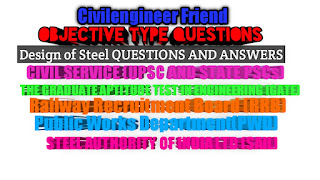Design of Steel Structures objective question and answer


Question No. 306
For the steel member exposed to weather and accessible for repainting, the thickness of steel
should not be less than (accepting the webs of Indian Standard rolled steel joists and channels).
(A) 4 mm
(B) 6 mm
(C) 8 mm
(D) 10 mm
Answer: Option B
Question No. 307
The permissible stress in bending for rolled steel I-beams and channels, is
(A) 1500 kg/cm2
(B) 1575 kg/cm2
(C) 945 kg/cm2
(D) 1650 kg/cm2
Answer: Option D
Question No. 308
The distance measured along one rivet line from the centre of a rivet to the centre of adjoining
rivet on an adjacent parallel rivet line, is called
(A) Pitch of rivet
(B) Gauge distance of rivet
(C) Staggered pitch
(D) All the above
Answer: Option C
Question No. 309
The effective length of a simply supported beam with ends restrained against torsion, and also
the ends of compression flange partially restrained against lateral bending, is given by
(A) L = span
(B) L = 0.85 span
(C) L = 0.75 span
(D) L = 0.7 span
Answer: Option B
Question No. 310
The permissible bearing stress in steel, is
(A) 1500 kg/cm2
(B) 1890 kg/cm2
(C) 2025 kg/cm2
(D) 2340 kg/cm2
Answer: Option B
Question No. 311
Strengths of a rivet in single shearing, in bearing and in tearing are 3425 kg, 4575 kg and 5025 kg
respectively. If the load in the member is 35 tonnes, the number of rivets required, is
(A) 10
(B) 11
(C) 12
(D) 13
Answer: Option D
Question No. 312
The bending moment for filler joists at the middle of an intermediate span, is
(A) WL²/10
(B) - WL²/10
(C) - WL²/12
(D) WL²/12
Answer: Option D
Question No. 313
A simply supported beam carrying a central load, will be safe in deflection if the ratio of its span to
depth, is
(A) < 19
(B) < 24
(C) > 19
(D) > 24
Answer: Option B
Question No. 314
When a load is transferred through one surface to another surface in contact, the stress is known
as
(A) Tensile stress
(B) Compressive stress
(C) Shearing stress
(D) None of these
Answer: Option D
Question No. 315
If p and d are pitch and gross diameter of rivets, the efficiency ( ) of the riveted joint, is given by
(A) = p/p - d
(B) = p/p + d
(C) = p - d/p
(D) = p + d/p
Answer: Option C
Question No. 316
The slenderness ratio of a column is zero when its length
(A) Is zero
(B) Is equal to its radius of gyration
(C) Is supported on all sides throughout its length
(D) Is between the points of zero moments
Answer: Option D
Question No. 317
A 20 mm dia steel bar which is subjected to an axial tension of 2300 kg/cm2
produces a strain of
0.004 cm. If Young's modulus of steel is 2.1 × 106
kg/cm2
, the bar is
(A) In the elastic range
(B) In the plastic range
(C) At yield point
(D) None of these
Answer: Option A
Question No. 318
The maximum axial load which is just sufficient to keep a column in a small deflected shape, is
called
(A) Crippling load
(B) Buckling load
(C) Critical load
(D) All the above
Answer: Option D
Question No. 319
Spans of continuous fillers are considered approximately equal if the longest span does not exceed
the shortest span by more than
(A) 5 %
(B) 10 %
(C) 15 %
(D) 20 %
Answer: Option C
Question No. 320
The ratio of the span L of the filler joists to the depth d from the underside of the joist to the top
of the structural concrete, should not exceed
(A) 60
(B) 45
(C) 35
(D) 25
Answer: Option C
Question No. 321
With a percentage increase of carbon in steel, decreases its
(A) Strength
(B) Hardness
(C) Brittleness
(D) Ductility
Answer: Option D
Question No. 322
The allowable stress in axial tension is generally kept less if thickness of the member is more than
(A) 10 mm
(B) 12 mm
(C) 15 mm
(D) 20 mm
Answer: Option D
Question No. 323
The maximum permissible slenderness ratio of compression member carrying dead and
superimposed load, is
(A) 180
(B) 200
(C) 250
(D) 350
Answer: Option A
Question No. 324
Tacking rivets in compression plates not exposed to the weather, have a pitch not exceeding 300
mm or
(A) 16 times the thickness of outside plate
(B) 24 times the thickness of outside plate
(C) 32 times the thickness of outside plate
(D) 36 times the thickness of outside plate
Answer: Option C
Question No. 325
A single angle in tension is connected by one leg only. If the areas of connecting and outstanding
legs are respectively a and b, net effective area of the angle, is
(A) a - [b/{1 + 0.35 (b/a)}]
(B) a + [b/{1 + 0.35 (b/a)}]
(C) a - [b/{1 + 0.2 (b/a)}]
(D) a + [b/{1 + 0.2 (b/a)}]
Answer: Option B
Question No. 326
If L is the overall length of a combined footing having A as its area, d being the distance between
the centre of gravity of the base and centre of the base, the larger width b is
(A) (A/L) + (3Ad/L²)
(B) (A/L) + (6Ad/L²)
(C) (A/L) - (6Ad/L²)
(D) (A/L) - (3Ad/L²)
Answer: Option B
READ MORE






No comments:
Post a Comment
If you are getting more information from civilengineerfriend page please give your comments. Share the page information in your whatsapp group. Subscribe our page to get more information.